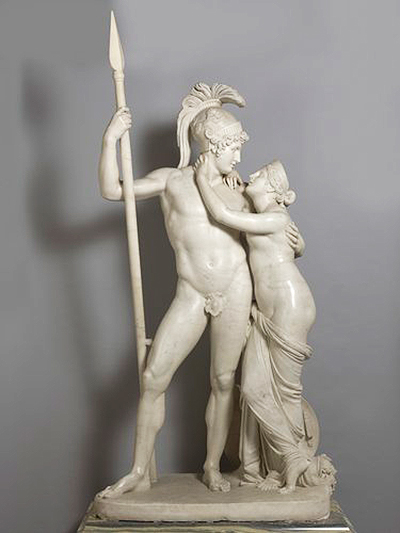Mars and Venus by Antonio Canova (1757 - 1822) is a full-length marble statue featuring the Roman deities Mars and Venus.
Inspired by both the baroque style and the classical revival, Canova nonetheless achieved a distinctive style which earned him the reputation as one of the greatest Italian neoclassical sculptors. Carved from a single block of marble Mars and Venus takes inspiration from the classical legends which inspired so much of Canova's work. The love story of Mars and Venus in classical mythology is one of an adulterous affair since Venus was married to the God Vulcan at the time. But in the many artworks the affair inspired, the adulterous nature is ignored to focus on the passionate and romantic love between the pair and Canova's sculpture is no exception to this.
In Canova's sculpture, Mars' warlike aspect is highlighted by the Roman helmet on his head and the spear in one hand. But his gaze is focussed on the goddess of love who has both arms around him and is looking adoringly up at him. As in classical sculpture the couple enjoy idealized anatomy but Canova also captures the sensuality of the embrace, moving it away from the cold artificiality which characterizes much of the classical revival. In creating his sculptures, Canova hired workers to carve the initial figure in the marble from a plaster form. With the fashion of the time being to view galleries in the evening, Canova would often put the final touches to his work by candlelight and used a variety of tools and methods including rubbing it with pumice stone or lead to recreate the sensitivity and softness of the flesh.
Mars and Venus is one of Canova's later works, created in the years 1817 - 1822. By then he was well-known and had completed many sculptures for the Bonaparte family in Italy. In 1815, after Napoleon's defeat, Canova was in London where he visited and was, perhaps, further inspired by the Elgin Marbles. He also met the Prince Regent (later King George IV) who commissioned the sculpture for his London residence, Carlton House. Coming after England's victory in the Battle of Waterloo, the statue can be seen as a representation of war and peace after the years of conflict. George IV received the statue in 1824 and displayed it in the Gothic Conservatory. Mars and Venus remain in royal hands to this day and is currently at one end of the Marble Hall in the London residence of Queen Elizabeth II, Buckingham Palace.




